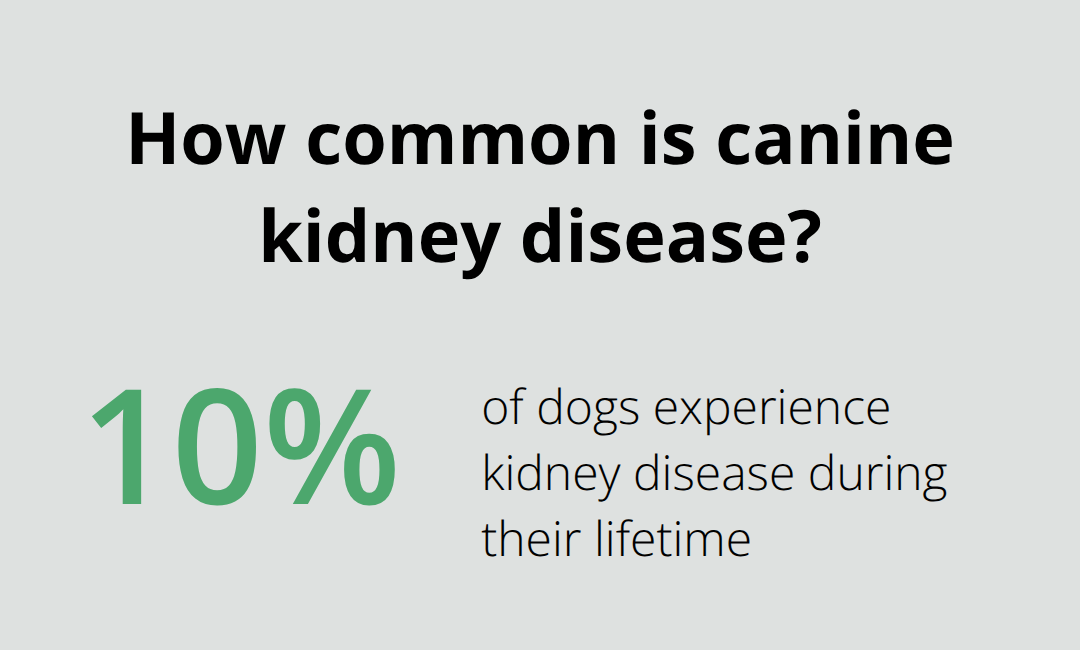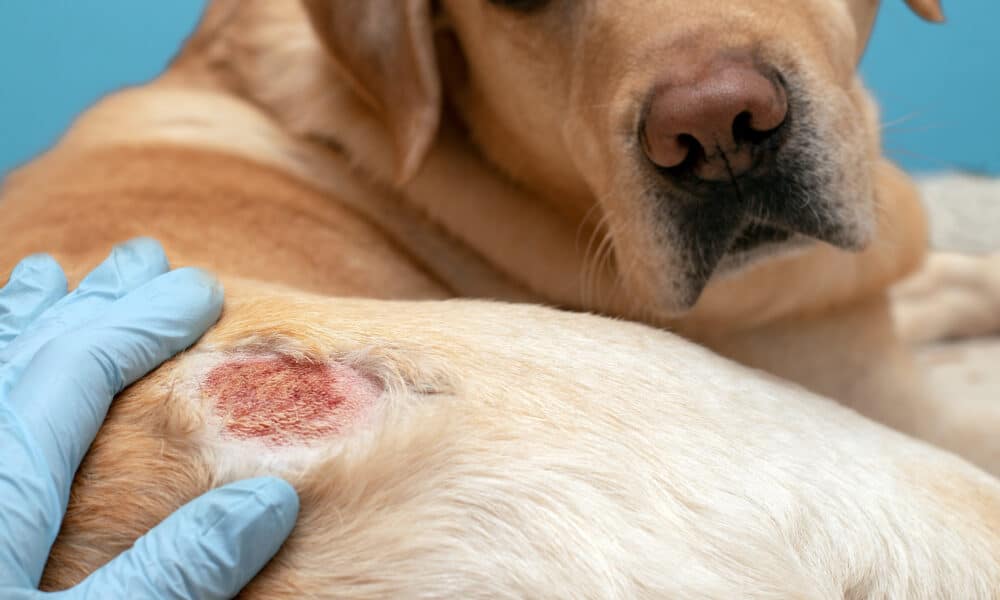
The constant scratching and licking your dog does can get very annoying for you. But for your furry friend? It’s causing more than just that – it is causing them major discomfort and irritation.
Dog skin conditions are very common. As a matter of fact, they are among the American Veterinary Medical Association‘s (AVMA) top health concerns in canines back in 2020. And therefore, are one of the most common reasons why dogs end up at their veterinarian’s office.
In this article, we’ll list down and discuss six of the most common dog skin conditions, including their symptoms and treatment types.
Signs And Symptoms Of Skin Problems In Dogs
Constant itching and licking are among the most obvious symptoms of dog skin conditions. But there are also some common telltale signs of a skin problem in dogs. And usually, these symptoms and their severity can vary depending on the specific condition.
Here are some of them:
- Inflammation
- Skin redness or discoloration
- Hair loss or bald patches
- Rashes or bumps
- Scabs
- Dry, flaky skin
- Scaly patches on skin
- Hot spots
6 Of The Most Common Dog Skin Conditions
Without further ado, here are six of the most common skin conditions that our furry friends can suffer from:
1. Skin Allergies
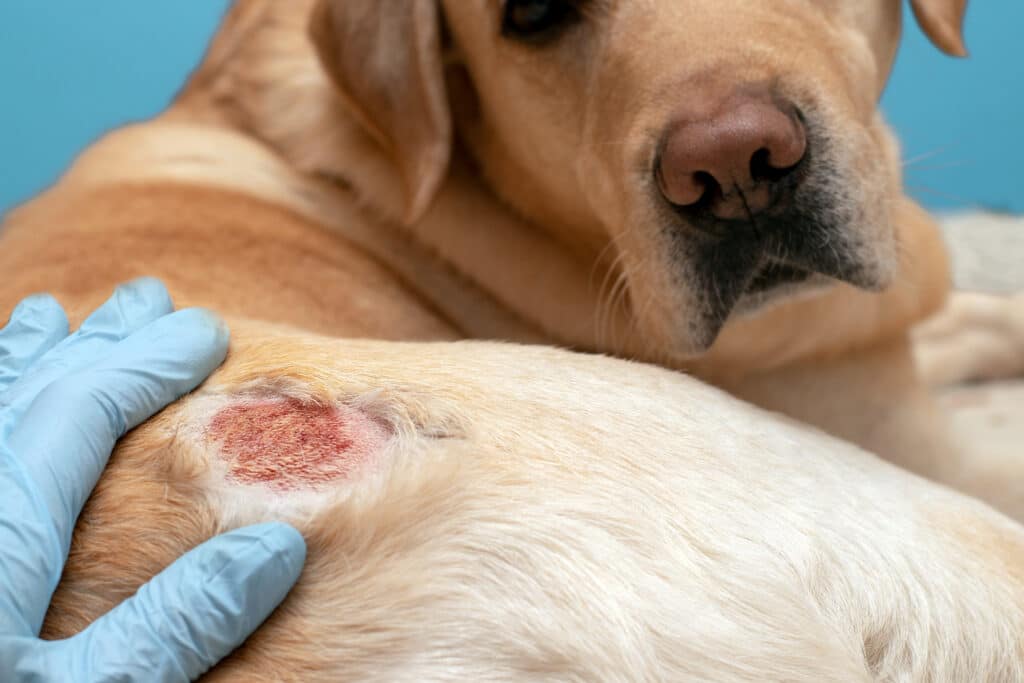
Dog skin allergies, or canine atopic dermatitis, are among the most common dog skin conditions. And they generally appear on the dog’s feet, armpits, chest, ears, and stomach.
Dogs with skin allergies generally suffer from red, itchy and irritated skin, which can be triggered by many, different factors. Our furry friends can be allergic to certain environmental factors like pollen or mildew, which are more prominent during the spring or summer season.
Dogs can also be allergic to certain ingredients of their food, such as beef, eggs, dairy, or wheat and suffer from food allergy.
Breeds Most Prone To Skin Allergies:
While any dog breed can suffer from skin allergies, according to the MSD Veterinary Manual, the following breeds are most susceptible to this health problem:
- Shih Tzu
- Golden Retriever
- Scottish Terrier
- Labrador Retriever
- Boxer
- Boston Terrier
- Dalmatian
Skin Allergy Treatment
There is no actual and permanent cure for skin allergies. However, there are various ways to reduce or eliminate the symptoms. Here are a few of them:
- Identify the allergens. You can do this yourself using the process of elimination or you can go to your dog’s vet and ask for an allergy test.
- Reduce the exposure to allergens. Once you have identified your dog’s allergens, it’s best to reduce their exposure to it. For example, if your dog has spring allergies, do not go on a walk in the morning when the pollen count is high.
- Medication. When the symptoms persist, it’s best to consult with the vet what kind of medication your dog should take.
- Use mild and hypoallergenic shampoo. Using mild and hypoallergenic shampoo will help get rid of allergens in your dog’s coat. Furthermore, these shampoos can help keep your dog’s skin and coat shiny and healthy. Here are a few options you can find on Amazon:
2. Fleas And Ticks
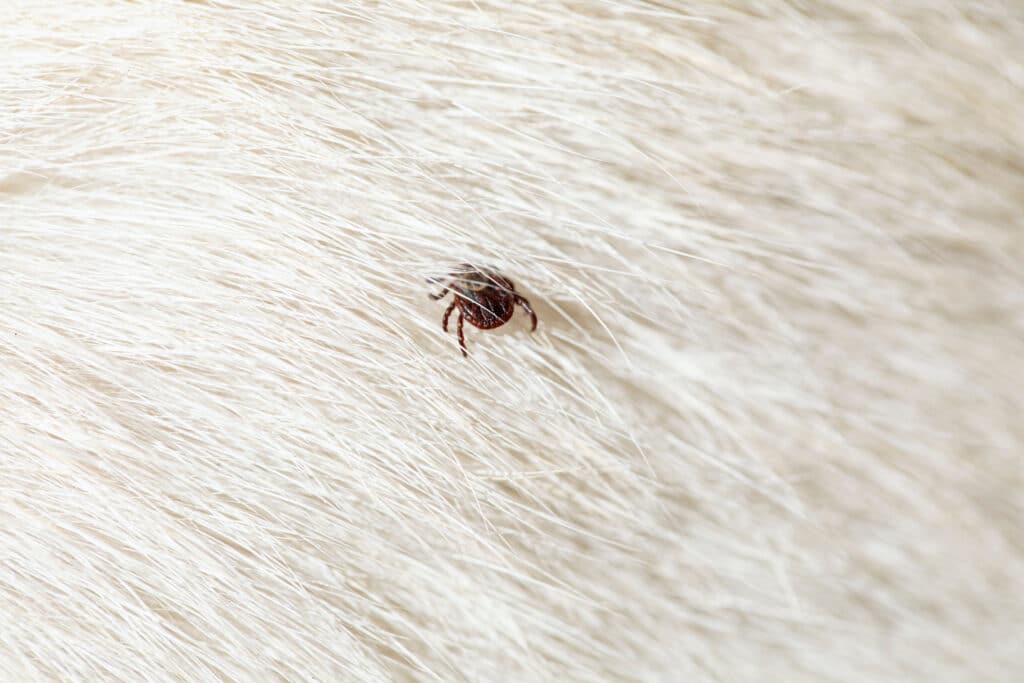
These external parasites can cause excessive licking and scratching in your dog. But aside from dog skin conditions, they can also cause other serious, and potentially, fatal diseases.
Fleas are tiny insects that can be hard to see in your dog’s coat. But when your dog is infested with these, they can develop scabs and hot spots due to the excessive itchiness. And when not treated correctly, severe flea infestations can cause serious problems like blood loss and anemia.
On the other hand, ticks are more visible to the naked eye. And they feed on your dog’s blood. Ticks may look harmless, but they can carry the bacteria that can cause Lyme disease in dogs.
Breeds Most Prone To Fleas and Ticks
No breed is safe from fleas and ticks. And all dogs can contract them. However, dogs with longer coats provide the perfect home for fleas and ticks.
Furthermore, a 2021 research shows that tick infestation is more common among gundog, terrier and pastoral breeds.
Fleas and Ticks Treatment
There are a plethora of ways to get rid of fleas and ticks. And some of the most common options include:
- Clean your home thoroughly. While not a treatment option in the literal sense, maintaining the cleanliness of your home will help get rid of fleas and their eggs inside your house. One effective way to do this is using baking soda to soak and clean carpets. You can also soak you and your pet’s bedding with hot, soapy water.
- Keep your dog indoors during flea season. Fleas are more prevalent during spring and summer. So, be more careful during these seasons and keep your dog indoors as much as you can.
- Medication. Medication such as Bravecto, NexGard and Credelio are safe and effective in getting rid of adult fleas and ticks, as long as they are attached to your dog’s skin and coat. However, it’s best to consult with your dog’s veterinarian first before letting your dog take any of these.
- Use a flea comb and tweezers. When finding and getting rid of these external parasites from your dog’s coat, a flea comb and a pair of tweezers can effectively do the job. Here are a few flea comb recommendations:
While others would recommend products such as flea collars and shampoos to treat dog skin conditions brought about by fleas and ticks, the effect of these products are not long-lasting and are often, ineffective.
3. Folliculitis
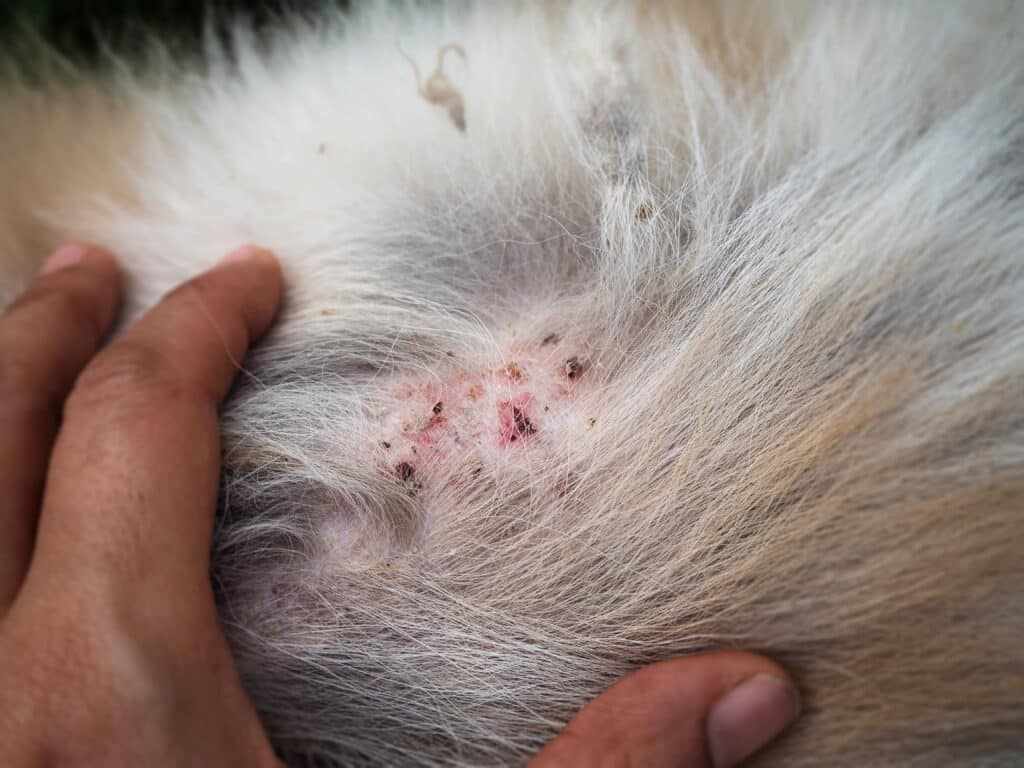
Folliculitis is one of the most common canine skin infection. It is a skin condition where the hair follicles become inflamed due to bacteria that resides on the surface of your dog’s skin.
It causes sores, lumps, and scabs on the skin. And this problem often occurs with other dog skin conditions such as mange or skin allergies.
Breeds Most Prone To Folliculitis
No breed is predisposed to Folliculitis. However, since this infection often occurs with other dog skin conditions, dog breeds that are more susceptible to other problems like skin allergies may also easily develop Folliculitis.
Furthermore, it is easier to detect Folliculitis in short-haired dog breeds because the inflammation of the hair follicles can be more obvious. However, in long-haired breeds, you may notice this problem when the coat starts looking a little dull and when it sheds more than usual.
Folliculitis Treatment
Since Folliculitis is common, effective treatment can be easily accessible. Here are treatment options for this skin condition:
- Topical therapy. This often involves the use of antibacterial shampoos to use for bathing, and topical creams to reduce the inflammation.
- Oral medication. If the problem is caused by bacterial infection, then your dog’s vet will most likely prescribe oral antibiotics. And depending on the severity of the problem, the vet may also prescribe oral pain killers to ease your pooch’s discomfort.
- Treatment of underlying disease. If Folliculitis happens in conjunction with another problem, then treatment will depend on the individual disease.
4. Ringworm
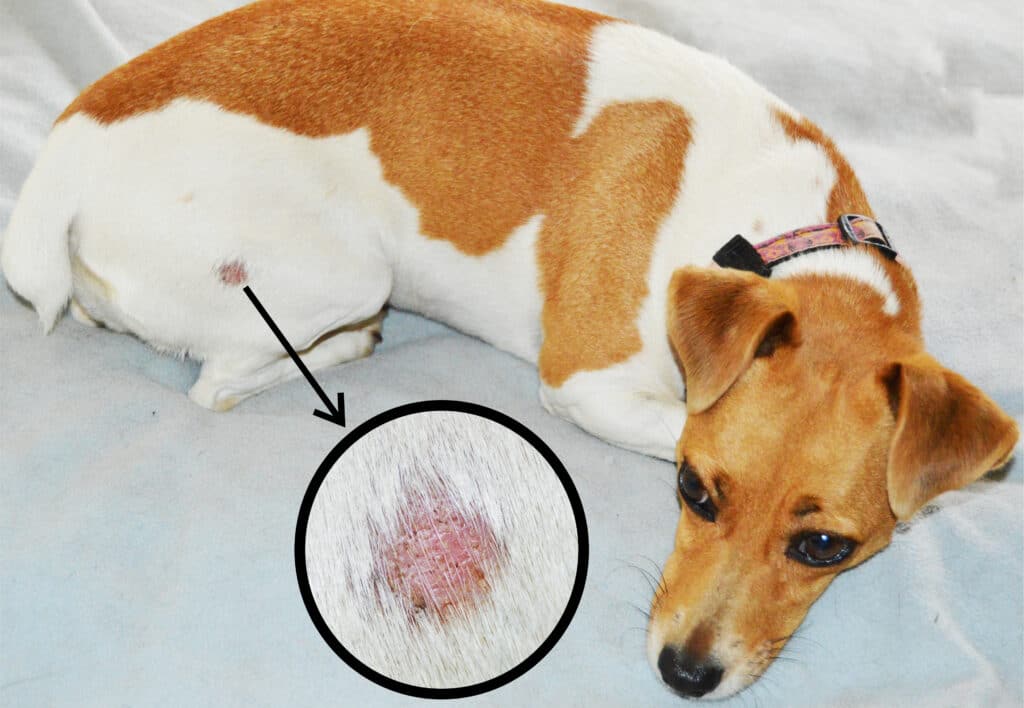
Ringworm, despite the name, is not caused by worms. As a matter of fact, it is caused by fungi. It is a common fungal infection and while not fatal, can be highly contagious to dogs, cats, and hoomans.
Unlike other dog skin conditions, ringworm usually starts in one area of the body, instead of appearing in several areas.
Furthermore, it appears as red, inflamed, circular patches and can appear anywhere. But it is most frequently found on a dog’s head, paws, ears, and front legs.
Breeds Most Prone To Ringworm
Like many dog skin conditions, any dog can have ringworm. However, there are three breeds that are more susceptible to ringworm than other canines, and they are:
- Boston Terrier
- Yorkshire Terrier
- Russell Terrier
Ringworm Treatment
While highly contagious, the good new is that, ringworm is curable. Here are treatment options for this skin condition:
- Quarantine. Since this dog skin condition is highly contagious to other pets and to people, the first thing to do is isolate your dog and limit their contact with any hoomans or pets. However, do not quarantine your pooch in a room with rugs or wood floors, because these are very difficult to clean and can easily be contaminated.
- Oral medication. For this treatment, you have to consult the best options with your dog’s vet. This is because there are different oral medications for ringworm that have their own side effects.
- Topical therapy. Like other dog skin conditions, ringworm can be treated with topical creams, ointment and shampoo. Furthermore, oral medication and topical therapy are often recommended to be used together because they are more effective that way.
If you’re looking for anti-fungal products, we recommend the following:
5. Mange
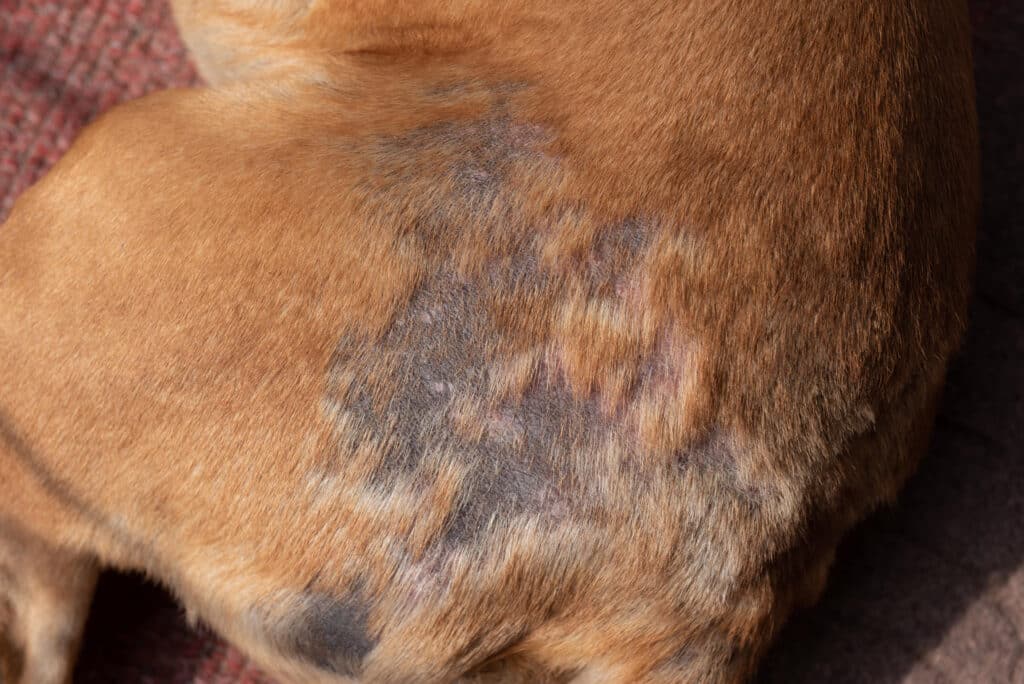
Mange is a skin problem caused by mites that live on a dog’s hair and skin. While it is often associated with neglected, and often, stray dogs, it is among the most common dog skin problems.
Like ringworm, mange is highly contagious and can easily spread from one dog to another. But unlike ringworm, the mites that cause mange cannot survive on us, hoomans.
Furthermore, there are two types of mange: demodectic mange and sarcoptic mange. Demodectic mange usually affects puppies (dogs below one year old) and is not usually contagious. Meanwhile, sarcoptic mange can affect any dog and is contagious.
When a dog has mange, you’ll notice intense itching, inflammation and hair loss. And if not treated immediately, can cause bald spots, scabbing, and sores all over your pooch’s body.
Breeds Most Prone To Mange
There are certain breeds that are more prone to both types of mange. For demodectic mange, the following breeds are more susceptible to it:
- Dalmatian
- American Bulldog
- American Pit Bull Terrier
- Old English Sheepdog
- Shar Pei
Meanwhile, according to a study, the following canine breeds are more prone to sarcoptic mange:
- British Bulldog
- Staffordshire Bull Terrier
- Shar-Pei
- Bordeaux Mastiff
- Pug
- French Bulldog
- Boxer
- Shih Tzu
- Border Terrier
Mange Treatment
There are various treatment types for this dog skin condition. And the treatment will depend on the severity and type of mange. But most of the time, a combination of the treatments mentioned below is used to resolve the infection.
- Topical medication. There are many topical medications used to treat mange. Some of these include selamectin (Revolution®), moxidectin + imidacloprid (Advantage Multi®, Advocate®) and topical fluralaner (Bravecto®).
- Oral medication. There are also oral medications to help treat mange. And depending on how severe the mange is, the vet may prescribe liquid, pill or flavored chewable medicine.
- Dips. Since mange can be uncomfortable due to intense itchiness, a lime-sulfur or amitraz dip is recommended. However, since there are newer and safer treatment options for mange, dipping is no longer commonly used.
If you suspect that your dog has mange, it’s always best to immediately bring your dog to a veterinarian. This way, your dog can be properly examined and appropriate treatment can be recommended.
6. Pyoderma
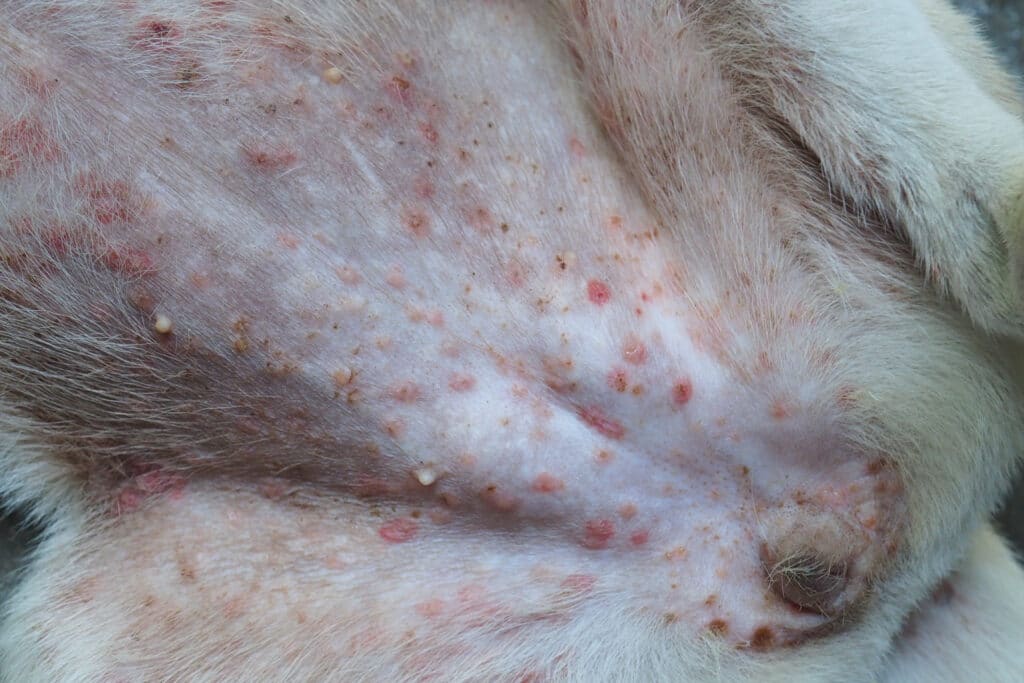
Pyoderma, also called Impetigo, is mostly caused by bacterial infections. However, it can also be caused by other underlying dog skin conditions such as inflammation or other serious diseases like Cushing’s disease or cancer.
It often appears as small, raised, red, and pus-filled blisters on a dog’s tummy. Furthermore, among all the dog skin conditions mentioned so far, this one is a lot more prevalent in puppies.
This dog skin condition is not fatal. However, if not dealt with correctly, can cause the infection to spread.
Breeds Most Prone To Pyoderma
Aside from puppies, there are also dog breeds that are more prone to this skin condition than others. And these are:
- Staffordshire Bull Terrier
- Bulldog
- Boxer
- Shar-Pei
Pyoderma Treatment
Generally, mild Pyoderma can be treated with topical medications. However, a number of treatment options are also available. See below to find out:
- Topical therapy. Usually, for mild cases of Pyoderma, topical solutions like creams or sprays can treat the problem.
- Antibiotic therapy. Antibiotic treatment is most commonly used to treat pyoderma. Usually, the vet will prescribe oral antibiotics that your dog will need to take for about three to four weeks to ensure effective treatment.
- Treatment of underlying disease. As mentioned above, Pyoderma can be caused by other dog skin conditions. In this case, the treatment options will depend on the specific underlying problem your dog has.
Conclusion
Keeping your dog’s skin and coat healthy is a must. If your pooch is showing any symptoms of the dog skin conditions mentioned above, then the best course of action is to visit the veterinarian clinic.
Whether it’s mild or severe, these dog skin conditions can be uncomfortable and cause damages to your furry friend’s overall health. So, it’s always best to deal with them promptly and correctly.



